It seems that everyone got into baking bread during lockdown in 2020! I tried it too, although I knew there was no way I would have the patience or stamina to make sour dough. My previous breadmaking attempt was Fermented Buckwheat Bread. I liked making this, as I prefer to avoid gluten, and it was (relatively) easy to make. But my partner Steve never really got the hang of it, as it is a different taste from what he is used to, so we were still buying bread for him.
After 2020 lockdown, we found a talented baker at the Takapuna Markets near us, who makes lovely wholegrain sour dough breads. As a result the bread making idea went on the back burner for a while.
Then the most recent lockdown hit! I'm writing this in October 2021, and we are now eight weeks into lockdown, and eight weeks without the lovely bread from the markets.
So, about a month ago, I started searching for bread recipe ideas that might work for us. I wanted a recipe that would work for my (lack of) interest in baking, and would meet our needs, by being:
- 100% whole grain
- no oil
- no salt
- vegan (so no dairy)
- super easy, and quick to make
I know! That's a hefty list, but I did find a recipe here for a bread that got very close to what we were looking for, and used it as my starting point. Then I started experimenting. I had some hilarious fails, when I tried adding some of the whole buckwheat I had on hand, which made the loaves go ballistic and spill all over the oven! But now, we are happy with the result, so here is the recipe we have settled on.
Steve's preferred breakfast is toast, topped with avocado (spiced with turmeric, black pepper, amla and cayenne pepper), then finished with Onion Jam. He is a happy camper with his new bread, and is planning on taking over the baking duties, so I can go keep making new recipes.
I hope you enjoy it too! Please let me know how you get on 🙂
About half an hour (or longer) before you want to start making the bread, add the freekah to a heatproof bowl. Pour over about a cup of boiling water and set aside. The freekah will expand and soften.
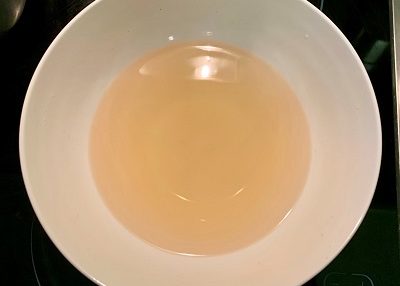
When ready to start making the bread, add the boiling water to a large heat proof bowl. Add the maple syrup and stir to integrate. Then add the cup of cold water and stir again.
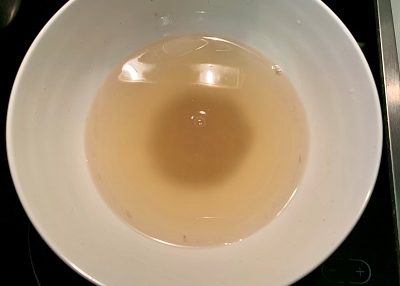
Add the yeast, and stir again. Set the bowl to one side for 10 minutes to allow the yeast to bloom.
Meanwhile, preheat the oven to 60 C, making sure the shelf is in the middle of the oven.
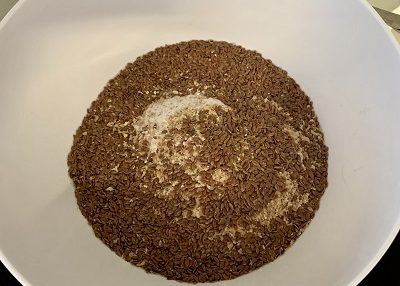
Measure the dry ingredients into a separate bowl.
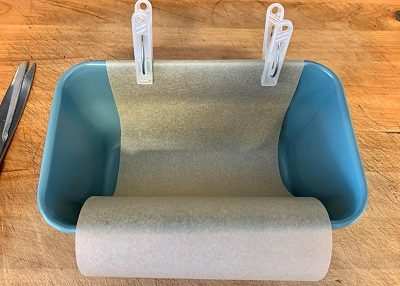
Line your loaf tin with non stick baking paper. My loaf tins are non-stick, so I just use a single piece of paper that is useful for removing the loaves at the end. If your loaf tins are not non stick, then you will need to line the whole tin. See below for more detail on loaf tin size.
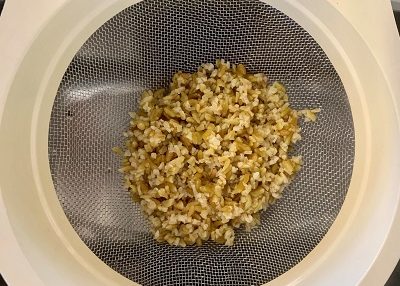
Before the 10 minutes is up, tip the freekah into a sieve to drain the water.
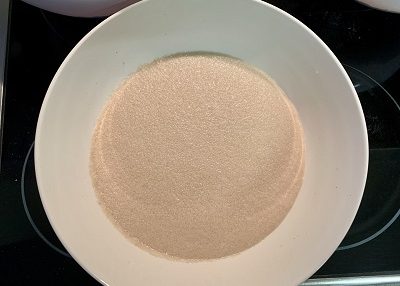
When the 10 minutes is up, the yeast will have bloomed and will look like this.
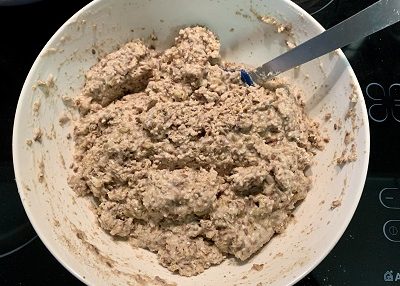
Add the dry ingredients and freekah to the yeast mixture. Stir until well combined.
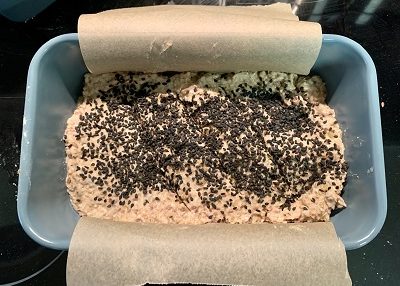
Tip the mixture into the lined loaf tin. Spread it out so that the top is level. Sprinkle on sesame seeds, if using. I have used black sesame seeds in this example.
Place the loaf into the middle of the oven, and bake for 20 minutes. This is the time when the bread gently rises.
At the end of the 20 minute rising period, turn the oven to 210 C and cook for a further 35 minutes. DO NOT open the oven door.
At the end of 35 minutes cooking time, remove the loaf from the oven. Remove the loaf from the tin and allow it to cool on a wire rack (so that it doesn't sweat, and get wet).
This is reasonably dense, Vogel's like bread. So, we find that it stores best it in the fridge, then slice and use it for toast most days. It would also freeze well, although we haven't had a chance to try that yet, due to it getting eaten too quickly!! If you did want to freeze it, I recommend slicing it and storing in serving size portions.
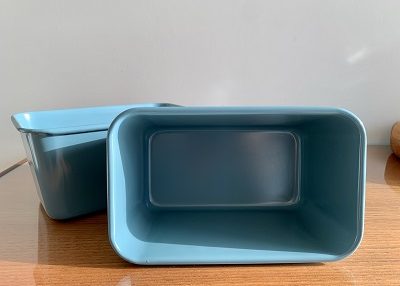
LOAF TINS
Many loaf tins seem to be sized for cake loaves rather than bread loaves, and have shallow sides. This bread is not kneaded, and when it rises, it takes the shape of the tin it is in. When I first made this bread it rose above the sides of the tins I had, and spread out, so that it had a "muffin top" shape. This is okay, but I wanted a more square slice. I spent some time researching tins, and the ones I have ended up with are Jamie Oliver brand. They come in two sizes, and I got the larger size (21 x 13 x 10.5cm). I bought mine from Chef’s Complements who, incidentally, were lovely to deal with.
SALT
Depending on where you are at with your taste buds and salt, you may not yet be ready to ditch salt from your bread altogether. We enjoy the taste of this bread without salt, but we have also been reducing salt over a long period of time, and our taste buds are more used to the natural taste of food. If you still want to have salt in your bread, just add 1 tsp of salt to the dry ingredients.
GLUTEN
For many years I have been avoiding gluten, as it tended to make my gut very uncomfortable, and cause me digestive issues. Which meant I mostly went without bread. I have noticed that since I have been eating a Whole Food Plant Based (WFPB) diet, that my sensitivity has gone down. For me, it seems to be refined flour that I have an issue with. When I eat this bread, with its whole grains, my tummy is fine.

YEAST
There seems to be so many types of yeast around, and for a non-baker like me, this can seem daunting. I have made this recipe using Edmonds Active Yeast. It is readily available at the supermarket, and you store it in the fridge once opened. I have found it to work reliably in this recipe.
FREEKAH
Freekah is a version of whole grain wheat. I buy it from my local bulk food store. If you can't find it, you can try bulgar (course grain), which works just as well.
STEEL CUT OATS
You could substitute whole (jumbo) rolled oats for steel cut oats, although the size of the steel cut oats is better, as they are smaller.
MAKE TWO LOAVES AT ONCE
Because we keep this bread in the fridge, it doesn't need to be day one fresh to eat. So, to save time, I make two loaves at a time, which works really well. It makes a heap of dishes to clean, but an hours work means you have plenty of bread for the upcoming week.
Ingredients
Directions
About half an hour (or longer) before you want to start making the bread, add the freekah to a heatproof bowl. Pour over about a cup of boiling water and set aside. The freekah will expand and soften.

When ready to start making the bread, add the boiling water to a large heat proof bowl. Add the maple syrup and stir to integrate. Then add the cup of cold water and stir again.

Add the yeast, and stir again. Set the bowl to one side for 10 minutes to allow the yeast to bloom.
Meanwhile, preheat the oven to 60 C, making sure the shelf is in the middle of the oven.

Measure the dry ingredients into a separate bowl.

Line your loaf tin with non stick baking paper. My loaf tins are non-stick, so I just use a single piece of paper that is useful for removing the loaves at the end. If your loaf tins are not non stick, then you will need to line the whole tin. See below for more detail on loaf tin size.

Before the 10 minutes is up, tip the freekah into a sieve to drain the water.

When the 10 minutes is up, the yeast will have bloomed and will look like this.

Add the dry ingredients and freekah to the yeast mixture. Stir until well combined.

Tip the mixture into the lined loaf tin. Spread it out so that the top is level. Sprinkle on sesame seeds, if using. I have used black sesame seeds in this example.
Place the loaf into the middle of the oven, and bake for 20 minutes. This is the time when the bread gently rises.
At the end of the 20 minute rising period, turn the oven to 210 C and cook for a further 35 minutes. DO NOT open the oven door.
At the end of 35 minutes cooking time, remove the loaf from the oven. Remove the loaf from the tin and allow it to cool on a wire rack (so that it doesn't sweat, and get wet).
This is reasonably dense, Vogel's like bread. So, we find that it stores best it in the fridge, then slice and use it for toast most days. It would also freeze well, although we haven't had a chance to try that yet, due to it getting eaten too quickly!! If you did want to freeze it, I recommend slicing it and storing in serving size portions.

LOAF TINS
Many loaf tins seem to be sized for cake loaves rather than bread loaves, and have shallow sides. This bread is not kneaded, and when it rises, it takes the shape of the tin it is in. When I first made this bread it rose above the sides of the tins I had, and spread out, so that it had a "muffin top" shape. This is okay, but I wanted a more square slice. I spent some time researching tins, and the ones I have ended up with are Jamie Oliver brand. They come in two sizes, and I got the larger size (21 x 13 x 10.5cm). I bought mine from Chef’s Complements who, incidentally, were lovely to deal with.
SALT
Depending on where you are at with your taste buds and salt, you may not yet be ready to ditch salt from your bread altogether. We enjoy the taste of this bread without salt, but we have also been reducing salt over a long period of time, and our taste buds are more used to the natural taste of food. If you still want to have salt in your bread, just add 1 tsp of salt to the dry ingredients.
GLUTEN
For many years I have been avoiding gluten, as it tended to make my gut very uncomfortable, and cause me digestive issues. Which meant I mostly went without bread. I have noticed that since I have been eating a Whole Food Plant Based (WFPB) diet, that my sensitivity has gone down. For me, it seems to be refined flour that I have an issue with. When I eat this bread, with its whole grains, my tummy is fine.

YEAST
There seems to be so many types of yeast around, and for a non-baker like me, this can seem daunting. I have made this recipe using Edmonds Active Yeast. It is readily available at the supermarket, and you store it in the fridge once opened. I have found it to work reliably in this recipe.
FREEKAH
Freekah is a version of whole grain wheat. I buy it from my local bulk food store. If you can't find it, you can try bulgar (course grain), which works just as well.
STEEL CUT OATS
You could substitute whole (jumbo) rolled oats for steel cut oats, although the size of the steel cut oats is better, as they are smaller.
MAKE TWO LOAVES AT ONCE
Because we keep this bread in the fridge, it doesn't need to be day one fresh to eat. So, to save time, I make two loaves at a time, which works really well. It makes a heap of dishes to clean, but an hours work means you have plenty of bread for the upcoming week.
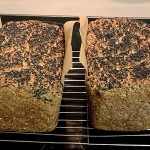
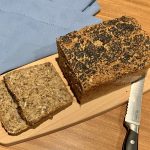
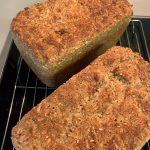











Leave a Reply